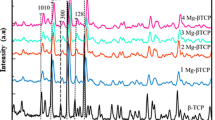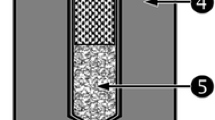Abstract
The influence of magnesium- and strontium-substitutions on injectability and mechanical performance of brushite-forming α-TCP cements has been evaluated in the present work. The effects of Mg- and Sr-substitutions on crystalline phase composition and lattice parameters were determined through quantitative X-ray phase analysis and structural Rietveld refinement of the starting calcium phosphate powders and of the hardened cements. A noticeable dependence of injectability on the liquid-to-powder ratio (LPR), smooth plots of extrusion force versus syringe plunger displacement and the absence of filter pressing effects were observed. For LPR values up to 0.36 ml g−1, the percentage of injectability was always higher and lower for Mg-containing cements and for Sr-containing cements, respectively, while all the pastes could be fully injected for LPR > 0.36 ml g−1. The hardened cements exhibited relatively high wet compressive strength values (~17–25 MPa) being the Sr- and Mg-containing cements the strongest and the weakest, respectively, holding an interesting promise for uses in trauma surgery such as for filling bone defects and in minimally invasive techniques such as percutaneous vertebroplasty to fill lesions and strengthen the osteoporotic bone.






Similar content being viewed by others
References
Gbureck U, Vorndran E, Muller FA, Barralet JE. Low temperature direct 3D printed bioceramics and biocomposites as drug release matrices. J Control Release. 2007;122:173–80.
Metallidis S, Topsis D, Nikolaidis J, Alexiadou E, Lazaraki G, Grovaris L, et al. Penetration of moxifloxacin and levofloxacin into cancellous and cortical bone in patients undergoing total hip arthroplasty. J Chemother. 2007;19:682–7.
Bohner M. Reactivity of calcium phosphate cements. J Mater Chem. 2007;17:3980–6.
Bohner M, Gbureck U, Barralet JE. Technological issues for the development of more efficient calcium phosphate bone cements: a critical assessment. Biomaterials. 2005;26:6423–9.
Fernandez E. Bioactive bone cements. Wiley Encyclopaedia of Biomedical Engineering. New York: Wiley; 2006.
Bohner M. Calcium orthophosphates in medicine: from ceramics to calcium phosphate cements. Inj-Intern Care Injur. 2000;31:37–47.
Dorozhkin SV. Calcium orthophosphates. J Mater Sci. 2007;42:1061–95.
Brown WE, Chow LC. A new calcium-phosphate setting cement. J Dent Res. 1983;62:672.
Wang XP, Ye JD, Wang H. Effects of additives on the rheological properties and injectability of a calcium phosphate bone substitute material. J Biomed Mater Res Appl Biomater. 2006;78:259–64.
Yuan HP, Li YB, de Bruijn JD, de Groot K, Zhang XD. Tissue responses of calcium phosphate cement: a study in dogs. Biomaterials. 2000;21:1283–90.
Alves HLR, dos Santos LA, Bergmann CP. Injectability evaluation of tricalcium phosphate bone cement. J Mater Sci Mater Med. 2008;19:2241–6.
Baroud G, Cayer E, Bohner M. Rheological characterization of concentrated aqueous á-tricalcium phosphate suspensions: the effect of liquid-to-powder ratio, milling time, and additives. Acta Biomater. 2005;1:357–63.
Boesel L, Reis RL. The effect of water uptake on the behaviour of hydrophilic cements in confined environments. Biomaterials. 2006;27:5627–33.
Bohner M, Baroud G. Injectability of calcium phosphate pastes. Biomaterials. 2005;26:1553–63.
Burguera EF, Xu HHK, Sun LM. Injectable calcium phosphate cement: effects of powder-to-liquid ratio and needle size. J Biomed Mater Res Appl Biomater. 2008;84:493–502.
Gauthier O, Muller R, von Stechow D, Lamy B, Weiss P, Bouler JM, et al. In vivo bone regeneration with injectable calcium phosphate biomaterial: a three-dimensional micro-computed tomographic, biomechanical and SEM study. Biomaterials. 2005;26:5444–53.
Baroud G, Wu JZ, Bohner M, Sponagel S, Steffen T. How to determine the permeability for cement infiltration of osteoporotic cancellous bone. Med Eng Phys. 2003;25:283–8.
Khairoun I, Boltong MG, Driessens FCM, Planell JA. Some factors controlling the injectability of calcium phosphate bone cements. J Mater Sci Mater Med. 1998;9:425–8.
Bai B, Jazrawi LM, Kummer FJ, Spivak JM. The use of an injectable, biodegradable calcium phosphate bone substitute for the prophylactic augmentation of osteoporotic vertebrae and the management of vertebral compression fractures. Spine. 1999;24:1521–6.
Ginebra MP, Rilliard A, Fernandez E, Elvira C, San Roman J, Planell JA. Mechanical and rheological improvement of a calcium phosphate cement by the addition of a polymeric drug. J Biomed Mater Res. 2001;57:113–8.
Sarda S, Fernandez E, Nilsson M, Balcells M, Planell JA. Kinetic study of citric acid influence on calcium phosphate bone cements as water-reducing agent. J Biomed Mater Res. 2002;61:653–9.
Gbureck U, Barralet JE, Spatz K, Grover LM, Thull R. Ionic modification of calcium phosphate cement viscosity. Part I: hypodermic injection and strength improvement of apatite cement. Biomaterials. 2004;25:2187–95.
Habib M, Baroud G, Gitzhofer F, Bohner M. Mechanisms underlying the limited injectability of hydraulic calcium phosphate paste. Acta Biomater. 2008;4:1465–71.
Barralet JE, Grover LM, Gbureck U. Ionic modification of calcium phosphate cement viscosity. Part II: hypodermic injection and strength improvement of brushite cement. Biomaterials. 2004;25:2197–203.
Sarda S, Fernandez E, Llorens J, Martinez S, Nilsson M, Planell JA. Rheological properties of an apatitic bone cement during initial setting. J Mater Sci Mater Med. 2001;12:905–9.
Leroux L, Hatim Z, Freche M, Lacout JL. Effects of various adjuvants (lactic acid, glycerol, and chitosan) on the injectability of a calcium phosphate cement. Bone. 1999;25:31–4.
Bigi A, Foresti E, Gandolfi M, Gazzano M, Roveri N. Isomorphous substitutions in beta-tricalcium phosphate: the different effects of zinc and strontium. J Inorg Biochem. 1997;66:259–65.
Kannan S, Lemos AF, Rocha JHG, Ferreira JMF. Characterization and mechanical performance of the Mg-stabilized á-Ca 3 (PO 4) 2 prepared from Mg-substituted Ca-deficient apatite. J Am Ceram Soc. 2006;89:2757–61.
Kannan S, Lemos IAF, Rocha JHG, Ferreira JMF. Synthesis and characterization of magnesium substituted biphasic mixtures of controlled hydroxyapatite/beta-tricalcium phosphate ratios. J Solid State Chem. 2005;178:3190–6.
Kannan S, Pina S, Ferreira JMF. Formation of strontium-stabilized á-tricalcium phosphate from calcium-deficient apatite. J Am Ceram Soc. 2006;89:3277–80.
Kannan S, Rocha JHG, Ferreira JMF. Synthesis and thermal stability of sodium, magnesium co-substituted hydroxyapatites. J Mater Chem. 2006;16:286–91.
Fadeev IV, Shvorneva LI, Barinov SM, Orlovskii VP. Synthesis and structure of magnesium-substituted hydroxyapatite 1. Inorg Mater. 2003;39:947–50.
Suchanek WL, Byrappa K, Shuk P, Riman RE, Janas VF, TenHuisen KS. Preparation of magnesium-substituted hydroxyapatite powders by the mechanochemical-hydrothermal method. Biomaterials. 2004;25:4647–57.
Lilley KJ, Gbureck U, Knowles JC, Farrar DF, Barralet JE. Cement from magnesium substituted hydroxyapatite. J Mater Sci Mater Med. 2005;16:455–60.
Rokita E, Hermes C, Nolting HF, Ryczek J. Substitution of calcium by strontium within selected calcium phosphates. J Cryst Growth. 1993;130:543–52.
Pina S, Olhero SM, Gheduzzi S, Miles AW, Ferreira JMF. Influence of setting liquid composition and liquid-to-powder ratio on properties of a Mg-substituted calcium phosphate cement. Acta Biomater. 2009;5:1233–40.
Mathew M, Schroeder LW, Dickens B, Brown WE. Crystal structure of alpha-Ca3(PO4)2. Acta Crys: Struct Commun. 1977;33:1325–33.
Yashima M, Sakai A, Kamiyama T, Hoshikawa A. Crystal structure analysis of beta-tricalcium phosphate Ca-3(PO4)(2) by neutron powder diffraction. J Sol St Chem. 2003;175:272–7.
Curry NA, Jones DW. Crystal structure of brushite, calcium hydrogen orthophosphate dihydrate – neutron-diffraction investigation. J Chem Soc. 1971;23:3725–9.
Xu HHK, Weir MD, Burguera EF, Fraser AM. Injectable and macroporous calcium phosphate cement scaffold. Biomaterials. 2006;27:4279–87.
Lemos AF, Ferreira JMF. Combining foaming and starch consolidation methods to develop macroporous hydroxyapatite implants. Bioceram. 2004;254:1041–4.
Bohner M, Gbureck U. Thermal reactions of brushite cements. J Biomed Mater Res Appl Biomater. 2008;84:375–85.
Olhero SM, Ferreira JMF. Influence of particle size distribution on rheology and particle packing of silica-based suspensions. Powder Technol. 2004;139:69–75.
Mezger TG. The rheology handbook: for users of rotational and oscillation rheometers. Hannover: Vicentz Verlag; 2002.
Alkhralsat MH, Marino FT, Rodriguez CR, Jerez LB, Cabarcos EL. Combined effect of strontium and pyrophosphate on the properties of brushite cements. Acta Biomater. 2008;4:664–70.
TenHuisen KS, Brown PW. Effects of magnesium on the formation of calcium-deficient hydroxyapatite from CaHPO4·2H2O and Ca4(PO4)2O. J Biomed Mater Res. 1997;36:306–14.
Grynpas MD, Hamilton E, Cheung R, Tsouderos Y, Deloffre P, Hott M, et al. Strontium increases vertebral bone volume in rats at a low dose that does not induce detectable mineralization defect. Bone. 1996;18:253–9.
Saint-Jean SJ, Camire CL, Nevsten P, Hansen S, Ginebra MP. Study of the reactivity and in vitro bioactivity of Sr-substituted à-TCP cements. J Mater Sci Mater Med. 2005;16:993–1001.
Khairoun I, Driessens FCM, Boltong MG, Planell JA, Wenz R. Addition of cohesion promoters to calcium phosphate cements. Biomaterials. 1999;20:393–8.
Duck FA. Physical properties of tissue: a comprehensive reference book. London: Academic Press Limited; 1990.
Acknowledgments
Thanks are due to CICECO for the support and to the Portuguese Foundation for Science and Technology for the fellowship grant of S. Pina (SFRH/BD/21761/2005). The first author is grateful to C. Stabler, from Institute of Mineralogie, University of Erlangen-Nuremberg, Germany, for his valuable help.
Author information
Authors and Affiliations
Corresponding author
Rights and permissions
About this article
Cite this article
Pina, S., Torres, P.M.C. & Ferreira, J.M.F. Injectability of brushite-forming Mg-substituted and Sr-substituted α-TCP bone cements. J Mater Sci: Mater Med 21, 431–438 (2010). https://doi.org/10.1007/s10856-009-3890-2
Received:
Accepted:
Published:
Issue Date:
DOI: https://doi.org/10.1007/s10856-009-3890-2




